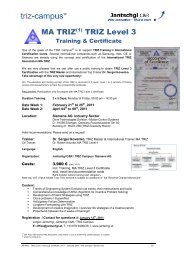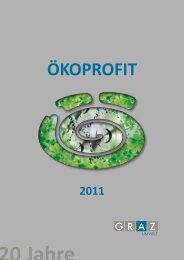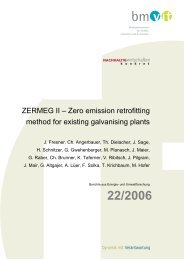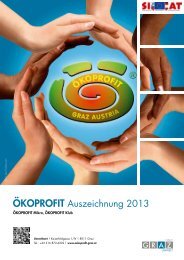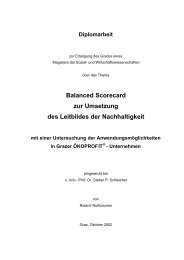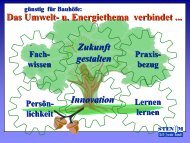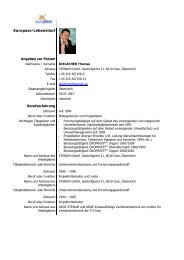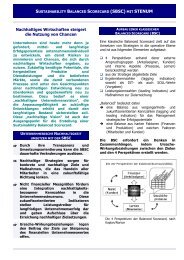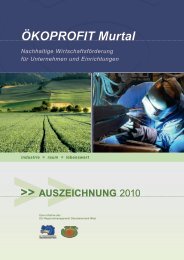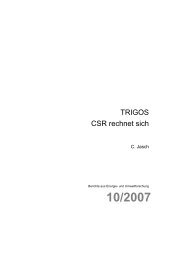Promoting Resource Efficiency in Small & Medium size ... - UNEP
Promoting Resource Efficiency in Small & Medium size ... - UNEP
Promoting Resource Efficiency in Small & Medium size ... - UNEP
You also want an ePaper? Increase the reach of your titles
YUMPU automatically turns print PDFs into web optimized ePapers that Google loves.
Hazardous substances and dangerous goods are chemicals for which<br />
a manufacturer or importer must provide a Material Safety Data Sheet<br />
(MSDS). A MSDS <strong>in</strong>cludes a characterisation of the materials, and<br />
guidel<strong>in</strong>es for handl<strong>in</strong>g, storage and safe disposal.<br />
Unsafe storage and handl<strong>in</strong>g of chemicals off-site by both dealers and<br />
end-users have documented environmental and health consequences 23<br />
because they frequently do not have the proper tra<strong>in</strong><strong>in</strong>g or knowledge<br />
regard<strong>in</strong>g the risks posed by products and used conta<strong>in</strong>ers. Additionally,<br />
accidents with hazardous substances can also occur dur<strong>in</strong>g transport<br />
e.g. on roads, railways or <strong>in</strong>land waterways. Transport accidents<br />
<strong>in</strong>volv<strong>in</strong>g hazardous substances can have severe consequences for the<br />
affected communities.<br />
Safer production aims at us<strong>in</strong>g less hazardous materials, understand<strong>in</strong>g<br />
the risks <strong>in</strong>volved and controll<strong>in</strong>g their use. Thus it m<strong>in</strong>imises<br />
the occurrence and harmful effects of technological accidents and<br />
environmental emergencies. The strategy is to identify and create<br />
awareness of risks <strong>in</strong> an <strong>in</strong>dustrialised community, to <strong>in</strong>itiate measures for<br />
risk reduction and mitigation, and to develop coord<strong>in</strong>ated preparedness<br />
between the <strong>in</strong>dustry, the local authorities and the local population.<br />
2.7 Integrated Management Systems<br />
An <strong>in</strong>tegrated management system is a management system that<br />
<strong>in</strong>tegrates responsibilities and procedures with regards to different<br />
aspects, such as quality, health and safety, environment and risk<br />
management, <strong>in</strong>to one complete framework, enabl<strong>in</strong>g an organization<br />
to work as a s<strong>in</strong>gle organism with clear and harmonized objectives.<br />
Instead of creat<strong>in</strong>g responsibilities for the different departments<br />
separately, an <strong>in</strong>tegrated management system provides one organised<br />
framework, by which each process is controlled with consideration to<br />
quality, health and safety, environment and risk management.<br />
An <strong>in</strong>tegrated management system allows a management team to create<br />
one system with a consistent set of process <strong>in</strong>dicators, objectives<br />
and measures. An <strong>in</strong>tegrated system provides a clear and holistic<br />
picture of all aspects of an organization, how they <strong>in</strong>teract and their<br />
associated risks. An <strong>in</strong>tegrated management system avoids duplication<br />
of documentation, tra<strong>in</strong><strong>in</strong>g and audit<strong>in</strong>g, and renders the ma<strong>in</strong>tenance<br />
of the system easier.<br />
An example of an <strong>in</strong>tegrated management system might be a comb<strong>in</strong>ation<br />
of the follow<strong>in</strong>g standards:<br />
Value of management<br />
<strong>in</strong>tegration<br />
Reduction of duplication<br />
Reduction of risks<br />
Balance of conflict<strong>in</strong>g objectives<br />
Elim<strong>in</strong>ation of conflict<strong>in</strong>g<br />
responsibilities<br />
Focus<strong>in</strong>g on bus<strong>in</strong>ess goals<br />
Formalisation of <strong>in</strong>formation<br />
<strong>in</strong> systems<br />
Harmonization and optimisation<br />
of practices<br />
Explanation<br />
Integrated management systems use a generic<br />
management model that encompasses environment,<br />
quality and risk management <strong>in</strong> one tool.<br />
Therefore redundancies <strong>in</strong> def<strong>in</strong><strong>in</strong>g responsibilities<br />
will be avoided and the duplication of documentation<br />
is m<strong>in</strong>imized, reduc<strong>in</strong>g the cost of ma<strong>in</strong>ta<strong>in</strong><strong>in</strong>g<br />
the management systems.<br />
A management system assesses risk to a company<br />
from different perspectives such as: environmental,<br />
quality management, and health and<br />
safety. This way, potential problems are more likely<br />
to be identified. Regulations and hazards are<br />
identified and measures taken to avoid them thus<br />
m<strong>in</strong>imiz<strong>in</strong>g unknown risks, and reduc<strong>in</strong>g costs for<br />
potential liabilities and for <strong>in</strong>surance.<br />
An <strong>in</strong>tegrated management system looks at the<br />
productive activities of a bus<strong>in</strong>ess and highlights<br />
conflict<strong>in</strong>g procedures and objectives. The systems<br />
can then help to resolve these conflicts.<br />
Clear structure makes conflicts of responsibility<br />
visible and helps resolve them through streaml<strong>in</strong>ed<br />
organisation.<br />
Harmoniz<strong>in</strong>g and coord<strong>in</strong>at<strong>in</strong>g different goals<br />
through a system makes it easier to move<br />
towards the company’s vision while not forgett<strong>in</strong>g<br />
the company’s environmental and societal<br />
responsibilities.<br />
Integrated management system uses one centralised<br />
<strong>in</strong>formation system with clear-cut <strong>in</strong>dicators<br />
and report<strong>in</strong>g system that m<strong>in</strong>imises <strong>in</strong>formation<br />
loss, <strong>in</strong>consistencies and mistakes because of<br />
miss<strong>in</strong>g <strong>in</strong>formation.<br />
Annual audit<strong>in</strong>g and review<strong>in</strong>g procedure optimise<br />
and streaml<strong>in</strong>e management practices and<br />
procedures systematically. Documentation of the<br />
audit is useful to measure progress towards company<br />
goals and <strong>in</strong>formation gathered can improve<br />
communication and be used to facilitate staff<br />
tra<strong>in</strong><strong>in</strong>g and development.<br />
• ISO 9001 (Quality Management)<br />
• ISO 14001 (Environmental Management)<br />
• OHSAS 18001 (Occupational Health & Safety)<br />
• ISO/IEC 27001 (Information Security)<br />
• ISO 22000 (Food Safety)<br />
• ISO/IEC 20000IT (Service Management)<br />
• ISO 31000 (Risk Management)<br />
2.8 Benchmark<strong>in</strong>g<br />
Benchmark<strong>in</strong>g is the process of compar<strong>in</strong>g one bus<strong>in</strong>ess to another<br />
one, by us<strong>in</strong>g key performance <strong>in</strong>dicators. In classical benchmark<strong>in</strong>g<br />
profit related <strong>in</strong>dicators, production cost, or productivity are used<br />
as <strong>in</strong>dicators. Apply<strong>in</strong>g benchmark<strong>in</strong>g to resource efficiency, the<br />
relevant <strong>in</strong>dicators relate to material and energy consumption, to waste<br />
generation and emissions.<br />
“Best practice benchmark<strong>in</strong>g” or “process benchmark<strong>in</strong>g” is a process<br />
<strong>in</strong> which organizations evaluate various aspects of their processes <strong>in</strong><br />
relation to <strong>in</strong>dustry standards. This then allows organizations to develop<br />
plans on how to make improvements or adapt specific best practices.<br />
When benchmark<strong>in</strong>g, companies need to be comparable <strong>in</strong> terms of<br />
products, processes, legal requirements, applicable prices, productivity,<br />
cost materials and energy use. Benchmark<strong>in</strong>g works best on a unit<br />
operations level, mean<strong>in</strong>g def<strong>in</strong>ed units that can be compared <strong>in</strong><br />
different companies and sometimes even across sectors, for example,<br />
boilers, refrigeration equipment, air compressors, wash<strong>in</strong>g operations.<br />
“Internal benchmark<strong>in</strong>g” is a process that tracks the company’s<br />
consumption patterns over time, and analyses it for variation; from this<br />
process, problems can be identified as well as good practices.<br />
Benchmark<strong>in</strong>g may be a one-off event, e.g. at the start of a resource<br />
efficiency project to analyse the status quo and the potential for<br />
improvement, but it is often treated as a cont<strong>in</strong>uous process <strong>in</strong> which<br />
organizations cont<strong>in</strong>ually seek to improve their practices.<br />
Table 4: Value of management <strong>in</strong>tegration<br />
23) <strong>UNEP</strong>, Safer Production, undated<br />
18



